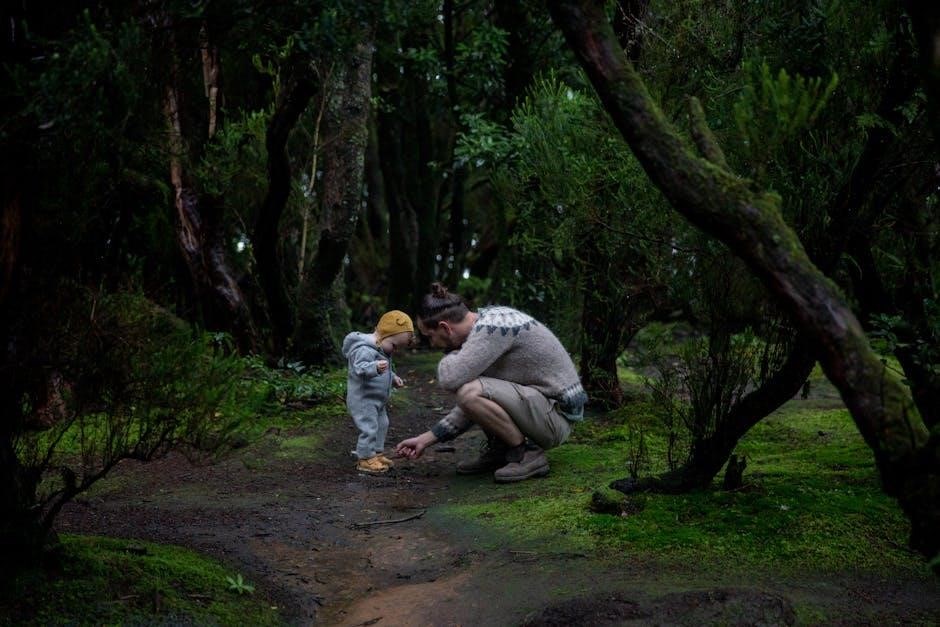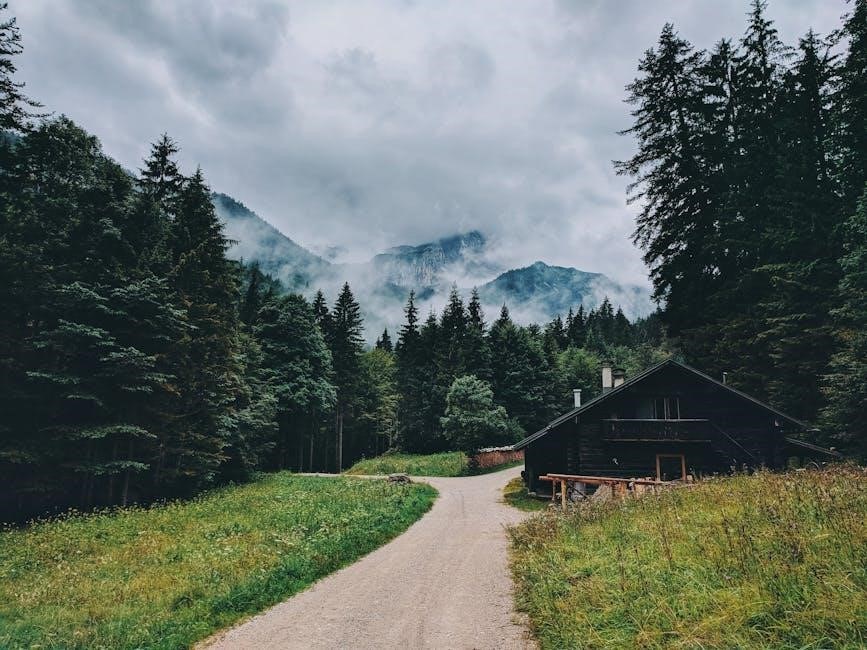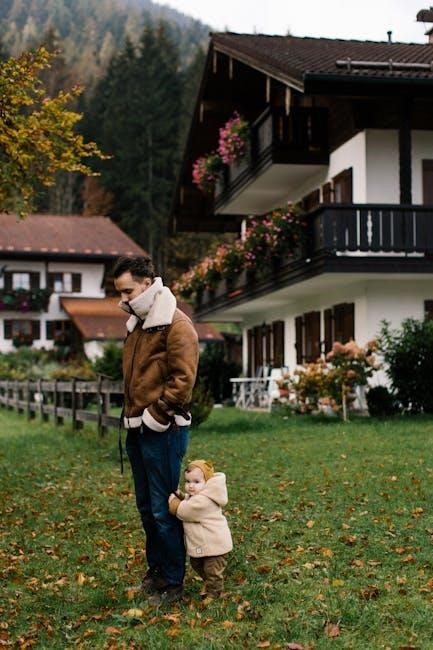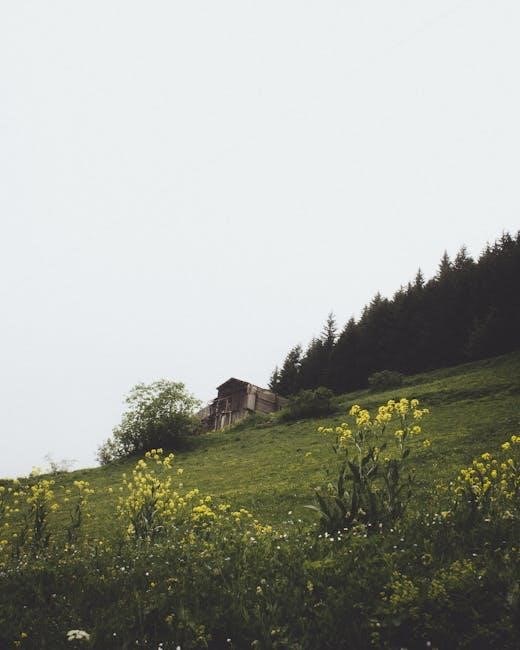Little House in the Big Woods PDF: An Overview
“Little House in the Big Woods”, the first book in Laura Ingalls Wilder’s series, is available in PDF. This autobiographical novel tells of life in 1870s Wisconsin. Discover frontier life, family bonds, and self-sufficiency. Enjoy the pioneer experience.

The Setting: Big Woods of Wisconsin in the 1870s
The story unfolds in the vast, untamed Big Woods of Wisconsin during the 1870s. This setting is more than just a backdrop; it’s a character itself, shaping the Ingalls family’s daily existence. Imagine dense forests stretching as far as the eye can see, where towering trees create a sense of both wonder and isolation.
Life in this era meant self-reliance. The Ingalls family lived in a little log cabin, their home a small pocket of civilization amidst nature’s grandeur. Resources were scarce, and the family relied on their skills to provide food, shelter, and entertainment. The woods offered both dangers and opportunities. Wild animals roamed freely, and the weather could be harsh. However, the forest also provided food, building materials, and a sense of freedom.
The Big Woods represent a time when families were deeply connected to nature. The setting emphasizes the importance of community, resilience, and the simple joys found in a life lived close to the land.

Laura Ingalls Wilder’s Autobiographical Novel
“Little House in the Big Woods” is more than just a story; it’s a window into the childhood of Laura Ingalls Wilder. This novel, published in 1932, is a fictionalized account of Laura’s early years growing up in a pioneer family. Wilder masterfully blends real-life experiences with narrative techniques.
The book offers a unique perspective, told through the eyes of a young girl. As we follow Laura, we witness her discoveries, fears, and joys. Wilder’s writing captures the innocence and curiosity of childhood, making the story both endearing and relatable.
While the story is based on real events, Wilder took some liberties with the timeline and details for narrative purposes. The novel reflects the values and challenges of pioneer life, while also celebrating family, resilience, and the beauty of the natural world. “Little House in the Big Woods” serves as a valuable historical and personal record. It preserves a glimpse into a bygone era through the lens of a young girl’s experiences.
Characters: Laura, Pa, Ma, Mary, and Carrie
“Little House in the Big Woods” introduces a memorable cast of characters, each playing a vital role in Laura’s life and the story’s narrative. The Ingalls family forms the heart of the novel, showcasing the dynamics and bonds that define their pioneer experience.
Laura, the protagonist, is a curious and adventurous young girl. Her perspective shapes the story, inviting readers to experience the world through her eyes. Pa, Charles Ingalls, embodies the spirit of the frontiersman. He is a skilled hunter, farmer, and carpenter, providing for his family with strength and resourcefulness.
Ma, Caroline Ingalls, represents the heart of the home. She is loving, patient, and resourceful, creating a sense of stability and warmth amidst the challenges of pioneer life. Mary, Laura’s older sister, is portrayed as well-behaved and obedient. She serves as a contrast to Laura’s more spirited nature. Carrie, the youngest sister, is a constant presence in the family. She adds to the dynamics of their daily life in the Big Woods.
Daily Life: Dangers and Joys
Life in the Big Woods of Wisconsin during the 1870s presented a unique blend of dangers and joys for the Ingalls family. Daily life was a constant negotiation with the unpredictable forces of nature. The family faced isolation, harsh weather conditions, and the threat of wild animals;
The dangers were real, but they were balanced by the simple joys of family, nature, and self-sufficiency. The Ingalls found joy in the changing seasons, the beauty of the natural world, and the satisfaction of providing for themselves. Evenings were spent with Pa playing his fiddle, Ma telling stories, and the girls learning valuable skills.
Laura’s narrative captures both the fear and excitement of living on the frontier. The close-knit family relied on each other for support and comfort. They faced challenges with resilience and found happiness in the everyday moments of their lives. The rhythm of daily life was dictated by the seasons and the needs of the family. This created a strong connection to the land and a deep appreciation for simple pleasures.

Providing for Themselves: Food and Entertainment
In “Little House in the Big Woods,” the Ingalls family’s self-sufficiency is vividly portrayed. Providing food and entertainment required resourcefulness and hard work. They grew vegetables, hunted for meat, and gathered wild berries and nuts from the surrounding woods. Ma preserved food for the winter months, ensuring the family had enough to eat during the long, cold months.
Entertainment was homemade and heartfelt. Pa’s fiddle provided music for singing and dancing. Ma told stories and taught the girls to sew and knit. Evenings were filled with shared activities that strengthened family bonds. They created their own fun, finding joy in simple pleasures.
The Ingalls family’s resourcefulness extended beyond food and entertainment. They made their own clothes, built their own furniture, and found ways to reuse and recycle everything. This self-reliance was a way of life, born out of necessity and shaped by the challenges of living on the frontier. This self-sufficiency fostered creativity, resilience, and a deep appreciation for the value of hard work and family.

Unit Studies and Worksheets
Enhance learning with “Little House in the Big Woods” unit studies! Explore chapter-by-chapter worksheets, quizzes, word searches, and research activities. These resources deepen understanding and engagement with Laura Ingalls Wilder’s classic story, bringing the Big Woods to life!
Reading Comprehension Quizzes
Assess understanding of “Little House in the Big Woods” with our comprehensive reading comprehension quizzes! Designed chapter-by-chapter, these quizzes test recall of key events, character details, and thematic elements. Each quiz features multiple-choice questions to evaluate comprehension efficiently.
Use these quizzes to reinforce learning, identify areas needing review, and track student progress. They are perfect for homeschoolers, classroom teachers, and individual readers who want to deepen their engagement with the book. The quizzes encourage active reading and critical thinking skills.
Our reading comprehension quizzes provide a structured way to ensure readers grasp the nuances of Laura Ingalls Wilder’s writing. They promote a deeper appreciation for the historical context, cultural values, and literary techniques employed in the novel.
These quizzes are an invaluable tool for educators and parents seeking to enhance the learning experience. By incorporating these assessments, you can foster a more meaningful and memorable connection with “Little House in the Big Woods”. Prepare to test your knowledge and uncover new insights into this beloved classic!
Word Searches and Scrambles
Engage with “Little House in the Big Woods” in a fun and interactive way through word searches and scrambles! These activities reinforce vocabulary and enhance familiarity with characters, settings, and themes from the book.
Word searches challenge readers to locate hidden words related to the novel within a grid of letters. Scrambles require unscrambling jumbled letters to form words from the story. Both activities are designed to be enjoyable and educational.
These word puzzles are perfect for students of all ages, offering a playful approach to learning. They promote problem-solving skills, enhance spelling abilities, and encourage active recall of information.
Incorporate word searches and scrambles into your study of “Little House in the Big Woods” to add variety and excitement. These activities can be used as individual assignments, group projects, or as a fun way to reinforce learning at home.
Discover the joy of learning while exploring the world of Laura Ingalls Wilder through these engaging word puzzles! Test your knowledge, challenge your skills, and have fun along the way.
Research Activities
Dive deeper into the world of “Little House in the Big Woods” with engaging research activities! Explore the historical context, cultural details, and natural elements that shaped Laura Ingalls Wilder’s childhood.
Research the Big Woods of Wisconsin in the 1870s. Investigate the types of trees, animals, and plants that thrived in the region. Discover the challenges and opportunities of pioneer life during that era.
Learn about the Ingalls family’s lifestyle. Explore their food preservation techniques, clothing styles, and entertainment options. Compare and contrast their experiences with modern-day life.
Investigate the tools and technologies used by pioneers. Research the purpose and function of items like Pa’s gun, Ma’s butter churn, and the family’s wagon. Understand how these tools contributed to their self-sufficiency.
Explore the Native American cultures that coexisted with the pioneers. Learn about their traditions, beliefs, and interactions with settlers. Understand the complexities of their relationship with the Ingalls family.
Research activities provide a hands-on approach to learning, encouraging critical thinking and independent exploration. Embark on a journey of discovery and gain a deeper appreciation for the world of “Little House in the Big Woods.”
Little House on the Prairie TV Series Connection
While “Little House in the Big Woods” focuses on Laura’s early childhood, the beloved “Little House on the Prairie” TV series expands upon the Ingalls family’s story, depicting their move to Kansas and later to Walnut Grove, Minnesota. The series, starring Michael Landon as Pa and Melissa Gilbert as Laura, offers a visual interpretation of Wilder’s books, capturing the spirit of pioneer life.
Although the TV series deviates from the books in some aspects, it retains the core themes of family, resilience, and community. The show explores the challenges and triumphs of frontier life, depicting the Ingalls family’s struggles with poverty, illness, and natural disasters.
Comparing the book “Little House in the Big Woods” with the TV series provides an opportunity to analyze different interpretations of the same story. Consider how the characters are portrayed, the plotlines developed, and the historical context presented. Discuss the similarities and differences between the two mediums.
The TV series offers a broader scope, encompassing later events in Laura’s life, while “Little House in the Big Woods” provides an intimate glimpse into her formative years. Exploring both allows for a more comprehensive understanding of the Ingalls family’s journey.
Free eBook and PDF Downloads
Discover the charm of “Little House in the Big Woods” by accessing free eBook and PDF versions online. Numerous websites offer legal downloads of this classic children’s novel, allowing you to enjoy Laura Ingalls Wilder’s captivating storytelling at no cost.
Project Gutenberg, a renowned source for free eBooks, provides a digital version of “Little House in the Big Woods” in various formats, including EPUB, Kindle, and plain text. These formats are compatible with most e-readers, tablets, and computers.
Many online libraries and archives also offer PDF downloads of the book, often in scanned versions of the original printed editions. These PDFs retain the look and feel of the physical book, complete with illustrations and page layouts.
Before downloading, ensure the website is reputable and offers legal copies of the book. Look for sites with clear copyright information and user reviews.
Reading “Little House in the Big Woods” as an eBook or PDF provides convenience and accessibility. You can carry the story with you on your device and read it anytime, anywhere. Share the joy of this timeless tale with friends and family by easily distributing the digital version.
Enjoy the adventures of young Laura and her family in the Big Woods of Wisconsin!
